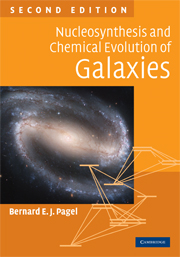Book contents
- Frontmatter
- Contents
- List of abbreviations
- Preface to the first edition
- Preface to the second edition
- 1 Introduction and overview
- 2 Thermonuclear reactions
- 3 Cosmic abundances of elements and isotopes
- 4 Cosmological nucleosynthesis and abundances of light elements
- 5 Outline of stellar structure and evolution
- 6 Neutron capture processes
- 7 Galactic chemical evolution: basic concepts and issues
- 8 Some specific GCE models and related observational data
- 9 Origin and evolution of light elements
- 10 Radioactive cosmochronology
- 11 Chemical evolution in other sorts of galaxies
- 12 Cosmic chemical evolution and diffuse background radiation
- Appendix 1 Some historical landmarks
- Appendix 2 Some physical and astronomical constants
- Appendix 3 Time-dependent perturbation theory and transition probabilities
- Appendix 4 Polytropic stellar models
- Appendix 5 Dissipation and abundance gradients
- Appendix 6 Hints for problems
- References
- Index
7 - Galactic chemical evolution: basic concepts and issues
Published online by Cambridge University Press: 05 June 2012
- Frontmatter
- Contents
- List of abbreviations
- Preface to the first edition
- Preface to the second edition
- 1 Introduction and overview
- 2 Thermonuclear reactions
- 3 Cosmic abundances of elements and isotopes
- 4 Cosmological nucleosynthesis and abundances of light elements
- 5 Outline of stellar structure and evolution
- 6 Neutron capture processes
- 7 Galactic chemical evolution: basic concepts and issues
- 8 Some specific GCE models and related observational data
- 9 Origin and evolution of light elements
- 10 Radioactive cosmochronology
- 11 Chemical evolution in other sorts of galaxies
- 12 Cosmic chemical evolution and diffuse background radiation
- Appendix 1 Some historical landmarks
- Appendix 2 Some physical and astronomical constants
- Appendix 3 Time-dependent perturbation theory and transition probabilities
- Appendix 4 Polytropic stellar models
- Appendix 5 Dissipation and abundance gradients
- Appendix 6 Hints for problems
- References
- Index
Summary
It ain't necessarily so.
It ain't necessarily so.
De t'ings dat yo' li'ble
To read in de Bible.
It ain't necessarily so.
George and Ira Gershwin, Porgy and BessIntroduction
Different aspects of the evolution of galaxies include dynamical, involving diffuse material (‘gas’, which will be understood to include dust), stars and dark matter; thermal (mainly affecting the gas); photometric + spectrophotometric (involving stars and gas); and so-called galactic chemical evolution (GCE) which is not really about chemistry (an important topic in its own right) but concerns the origin and distribution of nuclear species (loosely referred to as elements) in stars and gas. True insights into the origin and evolution of galaxies need studies of all these different aspects and their inter-relations, but there are several results of GCE that can be at least partially understood using only the very broadest ideas about other poorly understood aspects (e.g. the physics of galaxy and star formation) and this makes GCE a topic that is worth studying in its own right. At the same time, there are still many uncertainties, both in the underlying theory of stellar evolution, nucleosynthesis and mass loss and in the galactic context in which these basic element-forming processes take place. These limit the extent to which safe deductions can be made and motivate one to use the simplest possible models. The present chapter describes some basic principles, while the following one will discuss some specific models and related observational results.
- Type
- Chapter
- Information
- Nucleosynthesis and Chemical Evolution of Galaxies , pp. 225 - 250Publisher: Cambridge University PressPrint publication year: 2009



